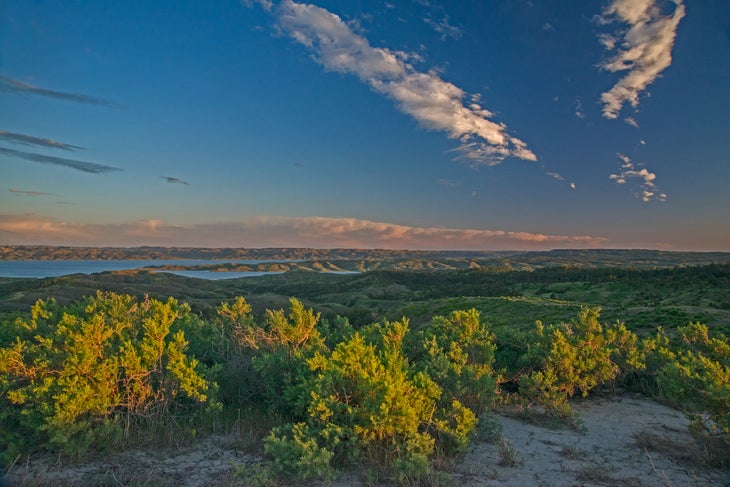A vast grassland in central Montana might seem like an odd place to go snorkeling. Comprising nearly 463,000 acres of private and leased public land centered on the , the reserve is decidedly un-tropical, a rolling shortgrass prairie that stretches out to the horizon, punctuated by smatterings of trees and rocky buttes. Unless you’re planning on jumping into the Missouri River, or you have the bad luck to be out when the snowmelt and spring rains turn the ground into gumbo-like mud, you’re unlikely to get wet. But to go “land snorkeling” on this largely trailless backcountry, you don’t need fins, a mask, or even water—just a willingness to rethink what a hike looks like.
The term “” may be unfamiliar. But the idea, as described by Clyde Aspevig and Carol Guzman, the Montana-based artists and longtime American Prairie volunteers who came up with it, is simple: Just wander through nature with no destination, paying close attention to the plants, animals, and natural features around you, like a snorkeler floating through the shallows of a coral reef. While every hiker has land snorkeled at some point in their life, it’s something many of us become less and less willing to dedicate our time to as we become more focused on making miles and reaching summits, says Anna Schale, American Prairie’s public access manager.
“Kids are really good at land snorkeling,” Schale says. “Any kid that sees a dandelion that has the white puff, they go straight to it, pick it up, and blow on it. I think somehow as adults, we really lose touch with looking at where our feet are moving.”
If you want to recapture that mindfulness and joy in the details of nature, Schale believes that the American Prairie is an ideal place to start your land snorkeling journey. Founded in 2001, the American Prairie Foundation aims to create a wildlife conservation preserve that they hope will eventually cover more than 3 million contiguous acres of never-plowed mixed grass prairie. Counting the adjacent Russell National Wildlife Refuge and , they’re nearly halfway there, with about 1.3 million acres of both private land and public land managed under grazing leases, where the foundation has reintroduced free-ranging herds of bison. Both the privately-owned and leased sections of the prairie are open to the public, including hikers, cyclists, horseback riders, and hunters. Wildlife abounds, including ungulates like deer and pronghorn, American porcupines, and prairie birds like sharp-tailed grouse and western meadowlarks.
Schale’s tips for beginner land snorkelers: Plan your day by time, rather than distance. Shift your mindset away from objectives. Instead, let your interest and the natural features of the land guide your walk.
“There are so many flowers that bloom close to the ground, grasses that are unique and different,” she says. “Even to the untrained eye, there’s just a lot to see in the variations of dirt—where it’s really crackly or maybe it’s different-colored. We have horned toads, woodhouse toads, and several kinds of bugs and beetles.” Dry creekbeds, she notes, can make for natural walking paths.
American Prairie is one of the most remote landscapes in the lower 48, with some sections located hours from pavement. Schale notes that it’s important to come prepared, even if you’re just planning on an aimless walk. Besides packing essential gear and bringing maps and appropriate layers—temperatures can vary from -40 °F to more than 100 °F throughout the year—it’s important to note that road conditions can be difficult, especially when rain and snow turns the dirt into “prairie gumbo” that can trap tires. Drive a high-clearance, four-wheel-drive vehicle, and check the weather forecast before you leave. With a few exceptions, most of the camping on the prairie is dry, so campers need to carry their water in with them.

Where to Go Land Snorkeling
Visitors to American Prairie can dispersed-camp almost anywhere they want, but Schale recommends that first-timers start at Antelope Creek Campground, a developed campsite just off US 191 featuring cabins ($73), camping ($20 for a tent spot; ), and a bathhouse, as well as potable water. Nearby attractions include a prairie dog town, wetlands, and a 2-mile interpretative trail—one of the few dedicated hiking paths on the preserve. For those ready to venture further, she recommends Buffalo Camp on the reserve’s Sun Prairie Unit. Like Antelope Camp, it has access to water and electric hookups meant for campers or small RVs; unlike that campground, it’s more than 50 miles from the nearest paved road, making it ideal for spotting the reserve’s bison herd and stargazing under its dark skies.
For a different perspective on the prairie, head to the reserve’s PN Unit at the junction of the Missouri and Judith Rivers, which features the steeper topography of the Missouri Breaks and a more forested vibe. Hikers there can spot wading birds like great blue herons and American avocets, find shells on the riverbanks, and wander the thick cottonwood galleries on their shores.


